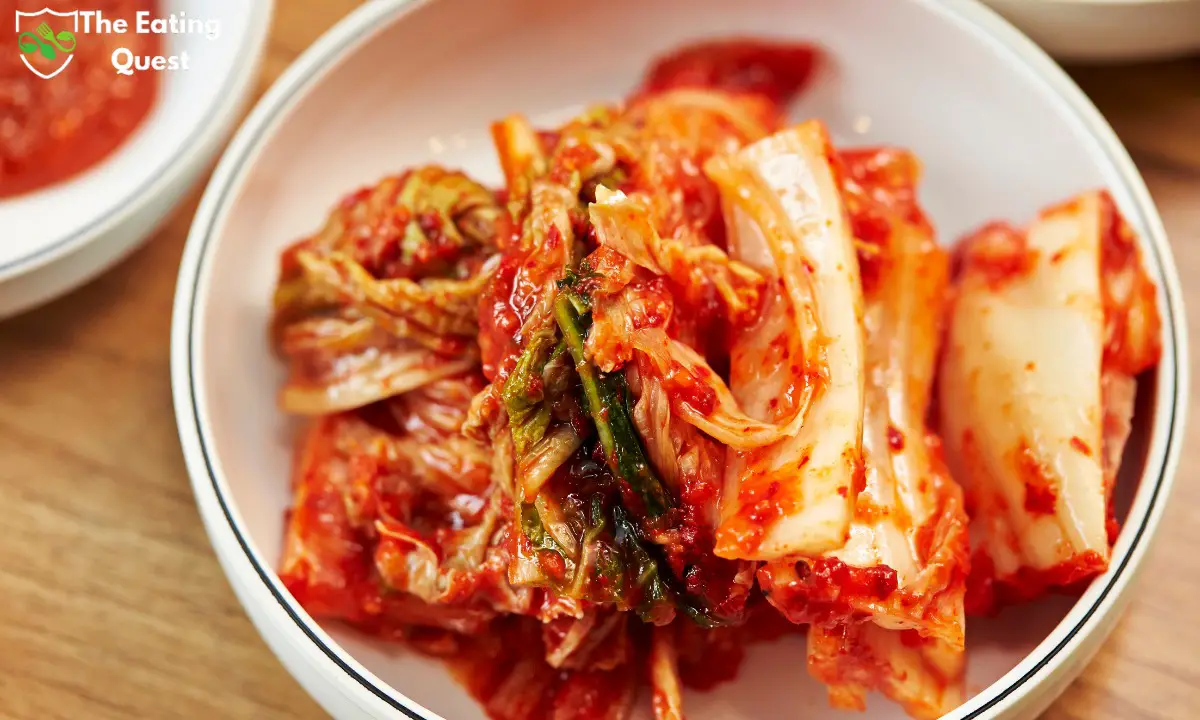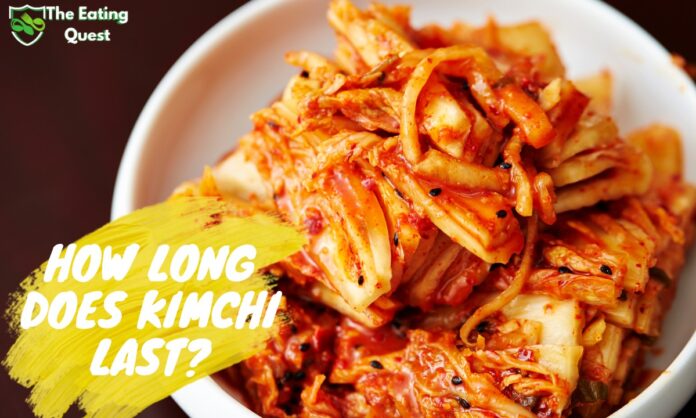If you’re a fan of Korean cuisine, then you’re probably familiar with kimchi. This popular fermented food is made from cabbage, radish, or other vegetables, mixed with spices and seasonings. Kimchi is known for its tangy, spicy, and slightly sour flavor, and it’s a staple in many Korean households. But if you’ve ever wondered how long kimchi lasts, you’re not alone.
The shelf life of kimchi depends on several factors, including the type of kimchi, how it’s stored, and the temperature of your fridge. Generally speaking, homemade kimchi will last longer than store-bought kimchi, as it contains fewer preservatives. However, even homemade kimchi will eventually go bad if it’s not stored properly. In the following paragraphs, we’ll explore how long kimchi lasts and how to tell if it’s gone bad.
What Does Kimchi Taste Like?
Kimchi is a traditional Korean dish that has been around for centuries. It is a spicy and sour fermented vegetable dish that is made with a variety of ingredients, such as cabbage, radish, garlic, ginger, and chili peppers.
The taste of kimchi can vary depending on the ingredients used and how long it has been fermented. Generally, kimchi has a tangy, spicy, and slightly sour taste. The spiciness level can range from mild to very spicy, depending on the amount of chili peppers used.
The texture of kimchi can also vary depending on the ingredients used. Cabbage kimchi has a crunchy texture, while radish kimchi has a softer texture.
The flavor of kimchi is complex and can be described as savory, umami, and slightly sweet. The fermentation process gives kimchi a unique flavor that is different from other pickled vegetables.
Kimchi is a versatile dish that can be used in a variety of ways, such as a side dish, a condiment, or as an ingredient in other dishes. Its bold flavor and health benefits have made it popular all over the world.
In summary, kimchi has a tangy, spicy, and slightly sour taste with a complex flavor that is savory, umami, and slightly sweet. Its texture can vary depending on the ingredients used, and it is a versatile dish that can be used in many ways.
How Long Does Kimchi Last
If you are a fan of kimchi, you may wonder how long it can last in your fridge or pantry. The answer depends on several factors, including the type of kimchi, how it was stored, and the temperature of your storage area.
Typically, fresh kimchi can last for up to 2 weeks in the fridge, while older kimchi can last for several months if stored properly. However, it is important to note that the longer kimchi is stored, the more sour and pungent it may become.
To ensure that your kimchi lasts as long as possible, it is important to store it in an airtight container in the fridge. You can also consider storing it in the freezer, which can extend its shelf life for up to six months.
If you notice any signs of spoilage, such as a foul odor or mold, it is best to discard the kimchi. Additionally, if you have had the kimchi for an extended period, it is always a good idea to give it a quick taste test before consuming to ensure that it is still fresh and safe to eat.
In summary, the shelf life of kimchi can vary depending on several factors, but with proper storage and handling, you can enjoy your favorite fermented dish for weeks or even months.
Is Kimchi Good for You?
Kimchi is a traditional Korean dish that has gained popularity worldwide due to its unique taste and potential health benefits. Here’s what you need to know about whether kimchi is good for you:
Nutritional Value of Kimchi
Kimchi is made from fermented vegetables, typically cabbage, and contains a variety of vitamins and minerals. One serving of kimchi (100g) typically contains:
- Calories: 18
- Protein: 1g
- Fat: 0g
- Carbohydrates: 4g
- Fiber: 2g
- Sodium: 747mg
- Vitamin C: 20% of the daily recommended intake
- Vitamin K: 25% of the daily recommended intake
Kimchi also contains probiotics, which are beneficial bacteria that can improve gut health.
Potential Health Benefits of Kimchi
Some studies suggest that consuming kimchi may have several health benefits, such as:
- Improving digestion: The probiotics in kimchi can help promote healthy digestion and reduce symptoms of digestive disorders.
- Boosting the immune system: Kimchi contains antioxidants and other compounds that may help strengthen the immune system.
- Lowering cholesterol: Some studies have found that consuming kimchi may help reduce levels of LDL (bad) cholesterol.
However, more research is needed to confirm these potential health benefits.
Considerations
While kimchi can provide several potential health benefits, it is also high in sodium. If you have high blood pressure or are on a low-sodium diet, you may want to limit your intake of kimchi.
Additionally, some people may be allergic to the ingredients in kimchi or may experience digestive discomfort after consuming it.
Overall, kimchi can be a healthy addition to your diet, but it’s important to consume it in moderation and listen to your body’s reactions.
Does Kimchi Go Bad?
Kimchi is a popular Korean dish made from fermented vegetables, such as cabbage, radish, and scallions. The fermentation process gives kimchi its unique tangy, spicy, and sour flavor. However, if you’re not careful, kimchi can go bad, and you may end up with a spoiled and potentially harmful dish.
The good news is that kimchi has a long shelf life, thanks to the fermentation process. If stored properly, kimchi can last for several months, even up to a year. However, there are a few things to keep in mind to ensure that your kimchi stays fresh and safe to eat.
One of the most important things to remember is to keep your kimchi refrigerated. Kimchi is a perishable food, and it needs to be stored at a temperature below 40°F (4°C) to prevent the growth of harmful bacteria. If left at room temperature for too long, kimchi can spoil quickly, and you’ll notice a sour, unpleasant smell.
Another thing to keep in mind is to use clean utensils when serving kimchi. If you use dirty utensils, you risk introducing harmful bacteria to the dish, which can cause it to spoil faster. It’s also a good idea to keep your kimchi covered when not in use to prevent contamination.
Finally, pay attention to the expiration date on the kimchi label. While kimchi can last for a long time, it’s still a perishable food, and it will eventually go bad. If you notice any signs of spoilage, such as a sour smell or a slimy texture, it’s best to discard the kimchi and not take any chances.
How to Eat Kimchi?
Kimchi is a versatile dish that can be enjoyed in many different ways. Here are some tips on how to eat kimchi:
- Eat it as a side dish: Kimchi is often served as a side dish with rice and other Korean dishes. It can add a spicy and tangy flavor to your meal.
- Use it as a topping: Kimchi can be used as a topping for burgers, tacos, and other dishes. It can add a unique flavor and texture to your favorite foods.
- Make kimchi fried rice: Kimchi fried rice is a popular Korean dish that is easy to make. Simply fry some rice with kimchi, vegetables, and meat or tofu for a delicious and filling meal.
- Add it to soups and stews: Kimchi can be added to soups and stews for extra flavor and nutrition. It can also help to balance out the richness of the broth.
- Make kimchi pancakes: Kimchi pancakes are a tasty and easy-to-make snack or appetizer. Simply mix kimchi with flour, eggs, and other ingredients, and fry in a pan until crispy.
Remember to always store kimchi properly in the refrigerator to ensure its freshness and longevity. With these tips, you can enjoy kimchi in many different ways and discover your favorite way to eat it.
What Do You Eat Kimchi With
Kimchi is a versatile side dish that can be paired with a variety of dishes to add flavor and nutrition. Here are some suggestions on what to eat kimchi with:
- Rice: Kimchi and rice is a classic combination in Korean cuisine. The spicy and sour flavors of kimchi complement the mildness of rice, making it a perfect match.
- Noodles: Kimchi can be added to noodle dishes such as ramen or stir-fried noodles to give them a tangy and spicy kick.
- Sandwiches: Kimchi can be used as a condiment in sandwiches, adding a unique flavor and texture to the mix.
- Tacos: Kimchi can be used as a topping for tacos, adding a spicy and crunchy element to the dish.
- Eggs: Kimchi can be added to scrambled eggs or omelets to give them a flavorful twist.
When it comes to eating kimchi, it can be consumed both hot and cold depending on personal preference. However, pregnant women should be cautious when consuming kimchi as it is a fermented food and may contain harmful bacteria. It is always best to consult with a doctor before adding kimchi to your diet while pregnant.
In conclusion, kimchi is a versatile and delicious side dish that can be paired with a variety of foods. Whether you like it hot or cold, there are plenty of ways to enjoy this Korean staple.

Can You Eat Kimchi While Pregnant?
As a pregnant woman, you may be wondering if it is safe to eat kimchi. Kimchi is a traditional Korean dish made from fermented cabbage, radish, or other vegetables, and is often seasoned with spicy chili flakes, garlic, and ginger.
The good news is that kimchi is generally safe to eat during pregnancy. However, there are a few things to keep in mind.
Firstly, it is important to make sure that the kimchi has been properly fermented and stored. If kimchi is not fermented correctly or stored at the wrong temperature, it can be contaminated with harmful bacteria that can cause food poisoning.
Secondly, some pregnant women may experience heartburn or indigestion when eating spicy foods like kimchi. If this is the case for you, it may be best to avoid or limit your intake of kimchi.
Lastly, it is important to note that kimchi is often served cold or at room temperature. While this may be delicious, it is generally recommended to heat up kimchi before eating it, especially during pregnancy. This can help to kill any harmful bacteria that may be present.
In summary, while it is generally safe to eat kimchi during pregnancy, it is important to make sure that it has been properly fermented and stored, to be mindful of any discomfort it may cause, and to heat it up before eating.
How to Store Kimchi?
Proper storage of kimchi is crucial to ensure that it stays fresh and flavorful for as long as possible. Here are some tips on how to store kimchi:
- Refrigerate immediately: After opening your jar or container of kimchi, make sure to store it in the refrigerator right away. Kimchi is a fermented food, and exposure to air and warmth can cause it to spoil quickly.
- Keep it airtight: Kimchi needs to be stored in an airtight container to prevent air from getting in and causing spoilage. Use a glass jar or a plastic container with a tight-fitting lid.
- Store in the coldest part of the fridge: Kimchi should be stored in the coldest part of your refrigerator, which is usually at the back. Avoid storing it in the door, as this area is subject to temperature fluctuations.
- Check for spoilage: Kimchi can last for several weeks or even months when stored properly, but it’s important to check for signs of spoilage before consuming. If you notice any mold, a slimy texture, or an off odor, discard the kimchi immediately.
- Freeze for long-term storage: If you have a large batch of kimchi that you won’t be able to consume within a few weeks, consider freezing it. Kimchi can be frozen for up to six months, but keep in mind that the texture may change slightly after thawing.
By following these simple tips, you can ensure that your kimchi stays fresh and delicious for as long as possible.
Do You Eat Kimchi Hot or Cold?
Kimchi is a Korean dish that can be eaten either hot or cold. It is a fermented vegetable dish that is traditionally made with cabbage, radish, and other vegetables. The fermentation process gives kimchi its unique tangy and spicy flavor.
When it comes to serving kimchi, there are no hard and fast rules. Some people prefer to eat it cold, straight out of the fridge, while others like to heat it up before serving. The choice is entirely up to you and your personal preference.
If you prefer to eat kimchi cold, you can simply take it out of the fridge and serve it as is. Cold kimchi is perfect for hot summer days and can be a refreshing addition to any meal. You can also use cold kimchi as a topping for sandwiches or burgers.
On the other hand, if you prefer to eat kimchi hot, you can heat it up in a pan or in the microwave. Heating up kimchi can help to bring out the flavors and make it even more delicious. You can also use hot kimchi as a topping for rice bowls or noodles.
Overall, whether you eat kimchi hot or cold is entirely up to you. Both options are delicious and offer their own unique flavor profiles. So, experiment with both and see which one you prefer!
How Long Do Opened Pickles Last Unrefrigerated
Pickles are a popular snack food that can be enjoyed on their own or added to sandwiches and salads. However, once you open a jar of pickles, it’s important to store them properly to prevent spoilage. If you leave opened pickles unrefrigerated, they can quickly spoil and become unsafe to eat.
According to food safety experts, opened pickles can last for up to two weeks at room temperature. However, this can vary depending on the type of pickles and how they were processed. Some pickles may contain preservatives that can extend their shelf life, while others may be more susceptible to spoilage.
To ensure that your opened pickles last as long as possible, it’s important to store them in a cool, dry place away from direct sunlight. You should also make sure that the jar is tightly sealed to prevent air and moisture from getting in.
If you’re unsure whether your opened pickles are still safe to eat, look for signs of spoilage such as mold, a slimy texture, or a foul odor. If you notice any of these signs, it’s best to err on the side of caution and throw them out.
In summary, opened pickles can last for up to two weeks unrefrigerated, but it’s important to store them properly and check for signs of spoilage before consuming them.
Frequently Asked Questions
What are the signs of spoiled kimchi?
Spoiled kimchi typically has a sour, unpleasant smell and a slimy texture. If you notice any mold or discoloration, it’s best to discard the kimchi to avoid any potential health risks.
Can you eat kimchi after the expiration date?
While kimchi can last for several months, it’s best to consume it before the expiration date to ensure its quality and safety. Eating kimchi after the expiration date may result in spoilage and potential health risks.
Is it safe to eat kimchi with white mold on it?
White mold on kimchi is not necessarily harmful, but it can affect the taste and texture of the kimchi. It’s best to remove the moldy parts and consume the remaining kimchi as soon as possible to avoid further spoilage.
What is the optimal fermentation time for homemade kimchi?
The optimal fermentation time for homemade kimchi can vary depending on personal preference and the recipe used. Generally, 2-5 days of fermentation at room temperature is recommended to achieve the desired flavor and texture.
What are the best practices for storing kimchi to extend its shelf life?
To extend the shelf life of kimchi, it’s important to store it in an airtight container in the refrigerator. Keeping it away from direct sunlight and at a consistent temperature can also help preserve its quality.
How should kimchi be stored once opened to maintain its quality?
Once opened, kimchi should be stored in an airtight container in the refrigerator to maintain its quality. It’s important to use clean utensils when serving to avoid introducing bacteria that can cause spoilage.
Also Read:
How Long Does Zucchini Last in the Fridge?
How Long Does Chick Fil A Sauce Last?
















